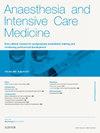Neurological and humoral control of blood pressure
IF 0.3
Q4 ANESTHESIOLOGY
引用次数: 0
Abstract
There is a relationship between arterial blood pressure, cardiac output and vascular resistance described mathematically, that helps us to understand short-term control of blood pressure in terms of a hydraulic system. Arterial baroreceptors are specialized sensors mediating a rapid response to changes in pressure through interaction with the autonomic nervous system. This in turn influences heart rate, inotropic state and vascular tone, altering distribution of blood between arterial and venous systems, compensating for acute changes in total blood volume. Total blood volume is controlled predominantly by the kidney, with the renin–angiotensin–aldosterone system acting as both the ‘sensor’ of blood pressure/volume (via the juxtaglomerular apparatus) and the ‘effector’ of blood pressure/volume (via renin and aldosterone secretion). Overall control is shared; the baroreceptors being responsible for mediating short-term changes, and renal mechanisms determining the long-term control of blood pressure. These systems have to be adaptable in order to deal with physiological variation in the delivery of blood to tissues from rest to exercise, and with the large shifts in blood volume seen in acute haemorrhage. Pathophysiological changes in these systems lead to maladaptive responses, with systemic hypertension the most commonly seen.
神经和体液控制血压
动脉血压,心排血量和血管阻力之间有一种数学上的关系,这有助于我们理解液压系统对血压的短期控制。动脉压力感受器是一种特殊的传感器,通过与自主神经系统的相互作用,介导对压力变化的快速反应。这反过来影响心率、肌力状态和血管张力,改变动脉和静脉系统之间的血液分布,补偿总血容量的急性变化。总血容量主要由肾脏控制,肾素-血管紧张素-醛固酮系统既是血压/容量的“传感器”(通过肾小球旁装置),也是血压/容量的“效应器”(通过肾素和醛固酮分泌)。整体控制是共享的;压力感受器负责调节短期变化,肾脏机制决定血压的长期控制。这些系统必须具有适应性,以便处理从休息到运动期间向组织输送血液的生理变化,以及急性出血时血容量的巨大变化。这些系统的病理生理变化导致适应不良反应,以全身性高血压最为常见。
本文章由计算机程序翻译,如有差异,请以英文原文为准。
求助全文
约1分钟内获得全文
求助全文
来源期刊

Anaesthesia and Intensive Care Medicine
ANESTHESIOLOGY-
CiteScore
0.50
自引率
0.00%
发文量
152
期刊介绍:
Anaesthesia and Intensive Care Medicine, an invaluable source of up-to-date information, with the curriculum of both the Primary and Final FRCA examinations covered over a three-year cycle. Published monthly this ever-updating text book will be an invaluable source for both trainee and experienced anaesthetists. The enthusiastic editorial board, under the guidance of two eminent and experienced series editors, ensures Anaesthesia and Intensive Care Medicine covers all the key topics in a comprehensive and authoritative manner. Articles now include learning objectives and eash issue features MCQs, facilitating self-directed learning and enabling readers at all levels to test their knowledge. Each issue is divided between basic scientific and clinical sections. The basic science articles include anatomy, physiology, pharmacology, physics and clinical measurement, while the clinical sections cover anaesthetic agents and techniques, assessment and perioperative management. Further sections cover audit, trials, statistics, ethical and legal medicine, and the management of acute and chronic pain.
 求助内容:
求助内容: 应助结果提醒方式:
应助结果提醒方式:


